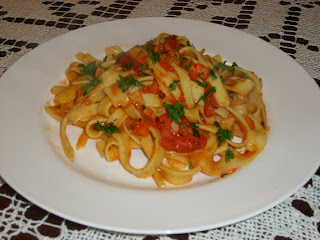The shank of the lamb, or any animal for that matter, is the section between the knee and the ankle. Lamb shanks have tons of flavor as well as connective tissue and marrow. This makes lamb shanks conducive to slow cooking methods. Slow cooking helps the connective tissue and marrow in the shank really melt and break down into pure deliciousness. Enough talking.
Slow Braised North African Lamb Shanks with Israeli Couscous
for the lamb:
4 Lamb Shanks (about 1.25 lbs. each)
1 large onion sliced
4 large tomatoes chopped
4 cloves garlic sliced
2 cups beef broth
1/2 cup red wine or beer
1/2 tsp cumin
1/2 ground coriander (you can substitute an extra 1/2 tsp of cumin)
1/4 tsp chili powder/cayenne pepper
olive oil
salt and pepper
chopped chives for garnish
for the couscous:
2 cups Israeli couscous (it's just like regular couscous but it has larger grains)
2 cups beef broth
1/4 cups slivered almonds
2 tsp olive oil
Preheat the oven to 325 degrees. Place a large heavy bottomed all-metal pot or dutch oven over medium heat. Coat the bottom of the pot with olive oil. Meanwhile season the shanks on all sides with salt and pepper. Brown the shanks, in batches of two, on all sides, 1o minutes per batch. Remove the shanks from the pot and set aside. Add the onions and garlic and saute until soft and translucent, 3-4 mins. Add the wine or beer and using a wooden spoon scrape off the little bits on the bottom of the pot. Add the tomatoes, beef stock, cumin, coriander, chili powder and season with salt and pepper. Bring the mixture to a boil. After the mixture comes to a boil nestle the shanks in the pot. Cover and place in the oven for 3 hours.
The shanks will be tender and almost falling off the bone. Remove them carefully from the pot. Strain the braising liquid to remove the solids. Return the remaining mixture to the pot and place over medium heat. Simmer the liquid until it reduces by half.
To prepare the couscous place a pot over medium low heat and add the olive oil. When its heated add the couscous. Stir the couscous continually until it turns a light brown color and has a nutty aroma. Then add the beef broth. Bring the mixture to a boil then turn the heat off cover the pot for 7 minutes. Fluff the couscous with a fork and add the almonds.
To serve, scoop some couscous onto a plate. Place the shank on top and pour a few spoonfuls of the reduced braising liquid on top. Sprinkle with the chives.























